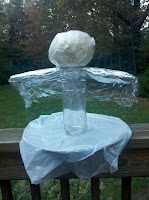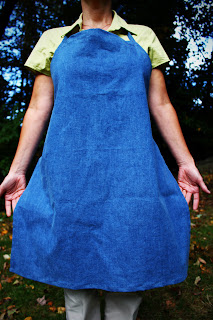Photo courtesy of dgartistics
While wracking my brain for this post I needed to get out and enjoy what was becoming a beautiful Fall day, the first after several days of rain during which my husband and I had not been able to continue our pursuit of exploring the local bike trails two miles or so at a time. The wind and rain had knocked a lot of the branches and leaves down so we had to keep an eye on where we were stepping more than usual. I began to take note of several fairly large leaves from different types of trees and I started to think of ways I could use them, perhaps as templates for a felt leaf runner or some painted project. The creative juices were beginning to flow again. Ahhhh.
Back at work the next day I began pouring through our Christmas books (hoping I could find a Christmas craft that I might translate into a Fall project). Luckily for me, my brain was now on Craftster overdrive from my hike when I picked up a new arrival:

I already had an old grapevine wreath stashed in my attic: an imagined project-to-be that never was. You see, unfortunately, the fine art of arranging plant materials is another craft that I am not particularly skilled in. My mother has a wonderful gift for creating clever, artistic arrangements. I do not. The extent of my ability has been to plop the whole bunch of flowers into a vase and pray they drape artfully. Sometimes a hopeful little nudge will create…something. (I fear you are going to begin to doubt the “Crafty” part of the blog title!! Fear not, I would never send you down any rabbit hole that I was not willing to fall into myself.)
So now, inspired by Paula Pryke’s book, and with my grapevine wreath dusted off, I return to our library shelves hoping to find something more exactingly instructional such as “put flower A into slot A and flower B, etc.” Floral crafting is not an exact art, however. None-the-less I find another book that will help guide my current endeavor:
Malcolm Hillier’s books never seem to disappoint me as they are thorough and contain beautiful photographs. This one is a good combination of the principals of arranging, what choices the arranger has, and inspirational ideas. It covers both fresh and dried flowers with a multitude of photographs of plant material options by season as well as occasion. It goes beyond wreaths and bouquets providing ideas for a variety of floral crafts such as garlands and ropes, flower pressing, potpourri as well as the tools and techniques (with diagrams) you might encounter.
If you want to try this and are not sure where to go, you might want to look into the annual Wreath Ramble at the Hill-Stead Museum in Farmington. This is a popular yearly event (this year it is on November 14 from 12 – 4 pm) during which, for a small fee, participants can stroll the Museum's grounds collecting materials like bittersweet, milkweed pods, ferns and berries. Then, with guidance from expert volunteers who have the supplies needed, you can create your own wreath. Click here, or on the museum’s name for more information.
Unfortunately, I could not wait for this year's Ramble so I approached my husband with the idea of looking for wreath making materials. One of the things I love about my husband is his enthusiasm. He may greet the statement, “Let’s go off the trails and look for plants for a wreath!” with a blank stare, but he is always game for a walk in the woods. And while he may not know what bittersweet or milkweed pods look like, or what I mean by “frothy spray type stuff, pods and plants that have texture,” when given an example or two he always rises to the challenge and is a great searcher. In fact, I am quickly in awe of his ability to spot a particular type of berry or plant waaayyy before I do and in no time at all we have a beautiful collection of plant materials to work with. This was actually a very nice way to spend the afternoon together on a beautiful Fall day.
Some of the materials we collected
(Please be reminded that it is important not to collect materials from privately owned property unless you have secured permission.)
Note: bring clippers, gloves and paper bags. Also, collect more than you think you will need because some will get crushed in transit and some may not be “right” for the arrangement. You will want to spray the more delicate pieces with ozone-friendly hairspray or some other fixative (outdoors if possible) to discourage any disintegration.
I wove bittersweet vines in and around the grapevine base, using a glue gun to secure them as needed (I sometimes adhered leaves or loose berries to exposed glue to cover it).
I randomly placed the rest of my materials through trial and error in a way that pleased me – alternately moving a piece around until it looked “right” and gluing it in place (make sure you like where you have it before you glue it).
I made pine cone “flowers” that I arranged here and there:
Here's how I made the pine cone flowers:
I snipped sections from the pine cone using my pruning shears.
I was able to make several flowers from each pine cone.
This is a close-up of one section.
Finally, I attached an old bird’s nest that I salvaged from a bush in my yard. I knew the nest was no longer in use and had been abandoned (never remove a nest from the wild that may still be inhabited or is in the process of being made). I also added a bird that I purchased from my local craft store.
And here is my completed wreath!
I encourage you to give this project a try, materials are prevalent right now and best of all, free! It is a beautiful season to forage for elements to use and rambling around the outdoors with your spouse, child, best friend, what-have-you is a great way to spend time together.
Little end note: If you are interested in visiting the Hill-stead Museum during any other part of the year you might be interested in reserving our library’s Museum Pass which is provided by the Friends of the Avon Free Public Library.









































